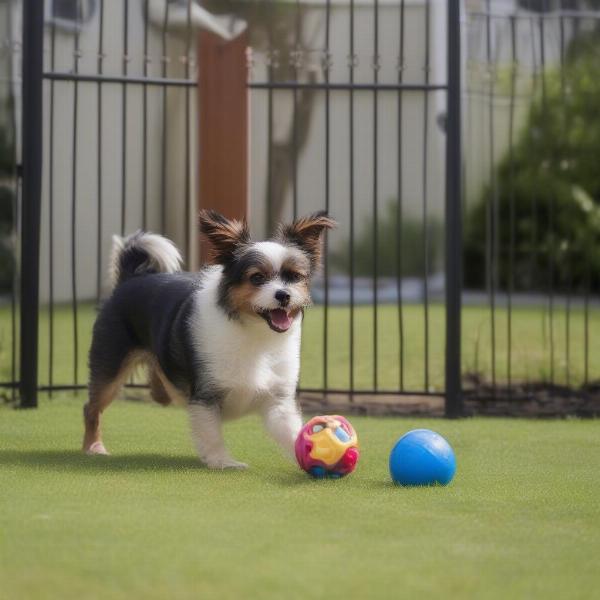A small dog fence is essential for keeping your pint-sized pal safe and contained. Whether you have a tiny terrier, a miniature dachshund, or a petite poodle, choosing the right fence can be a challenge. This article will guide you through the various options available, helping you select the perfect small dog fence to suit your needs and ensure your furry friend’s well-being.
Choosing the Right Small Dog Fence
Selecting the right small dog fence depends on various factors, including your dog’s breed, temperament, and your yard’s layout. Some small dogs are notorious escape artists, squeezing through seemingly impossible gaps. Others may be more laid-back but still require a secure boundary.
-
Traditional Fencing: While suitable for larger dogs, traditional fences might not be ideal for smaller breeds. Small dogs can easily slip through gaps in wooden fences or dig underneath chain-link. If opting for a traditional fence, ensure there are no gaps and the bottom is secured.
-
Invisible Fences: These electronic fences create a boundary using buried wires and a receiver collar worn by your dog. While effective for many small dogs, they don’t offer a physical barrier. This means other animals can still enter your yard, and a determined dog might still run through the boundary, receiving a shock in the process.
-
Portable Fencing: Ideal for temporary containment, portable fences are easy to set up and move. They’re great for travel, camping, or creating a designated play area in your yard. However, they may not be as sturdy as permanent solutions.
Material Considerations for Small Dog Fences
The material of your small dog fence is a crucial consideration. Durability, safety, and aesthetics all play a role.
-
Metal Fencing: Metal fences, such as aluminum or wrought iron, are durable and aesthetically pleasing. However, ensure the spacing between bars is narrow enough to prevent your small dog from squeezing through.
-
Vinyl Fencing: Vinyl is low-maintenance and comes in various styles. Like metal fencing, check the spacing for small dog suitability.
-
Wood Fencing: Wood offers a classic look but requires regular maintenance. Ensure there are no gaps or loose boards that your dog could exploit.
Height and Digging Prevention
Even with a seemingly secure fence, small dogs can be surprisingly adept at escaping.
-
Fence Height: While a taller fence might seem necessary, it’s more important to focus on preventing digging and squeezing through gaps. A shorter fence with no gaps is more effective than a tall fence with escape routes.
-
Digging Prevention: Bury chicken wire or L-footer wire along the fence line to deter digging. You can also place rocks or pavers along the bottom of the fence.
Maintaining Your Small Dog Fence
Regular maintenance is essential to ensure your small dog fence remains effective.
-
Inspections: Regularly inspect your fence for damage, loose boards, or gaps. Promptly repair any issues to prevent escapes.
-
Cleaning: Clean your fence periodically to remove dirt, debris, and potential hazards.
Creating a Safe and Enriching Environment
A fence provides safety and security, but it’s also important to create a stimulating environment for your small dog.
-
Enrichment Activities: Provide toys, chews, and interactive games to keep your dog entertained within the fenced area.
-
Socialization: Ensure your dog gets plenty of exercise and socialization outside the fenced area as well.
 Small dog playing in a fenced yard
Small dog playing in a fenced yard
“A properly installed and maintained small dog fence provides peace of mind for owners and a safe haven for their beloved companions,” says Dr. Emily Carter, DVM, a leading veterinary behaviorist. “It allows dogs the freedom to explore and play while remaining protected.”
Conclusion
Choosing the right small dog fence is a vital investment in your pet’s safety and well-being. By considering factors like breed, temperament, and yard layout, you can create a secure and enriching environment for your small companion. Remember to regularly inspect and maintain your fence to ensure its effectiveness. A well-chosen fence will give you peace of mind and allow your small dog to enjoy the outdoors safely.
FAQ
-
What is the best type of fence for a small dog? The best type depends on your dog’s individual needs and your yard. Invisible, portable, or traditional fences can all be suitable, but ensure it addresses your dog’s specific tendencies.
-
How tall should a fence be for a small dog? The height is less important than preventing digging and squeezing through gaps. A shorter fence with no escape routes is more effective than a tall one with vulnerabilities.
-
How can I prevent my small dog from digging under the fence? Bury chicken wire or L-footer wire, or place rocks/pavers along the fence line.
-
What materials are best for small dog fences? Metal, vinyl, and wood are all options, but ensure spacing is appropriate.
-
How do I choose the right invisible fence for my small dog? Consult with a professional to determine the appropriate signal strength and boundary size for your dog’s breed and temperament.
invisible pet fence for small dogs
electric dog fence for small dogs
portable outdoor dog fence
dog friendly pubs accommodation
ILM Dog is your trusted resource for expert advice on dog breeds, health, training, nutrition, grooming, and much more. We’re committed to providing dog owners worldwide with reliable, practical information to ensure their furry friends live happy, healthy lives. For expert guidance on choosing the right products and accessories for your small dog, contact us at [email protected] or +44 20-3965-8624. Visit ILM Dog today for more valuable resources.